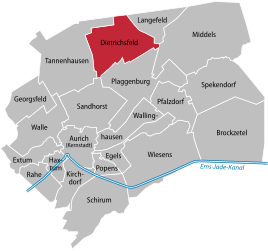Dietrichsfeld
|
Dietrichsfeld
City of Aurich
|
|
|---|---|
| Coordinates: 53 ° 31 ′ 58 ″ N , 7 ° 32 ′ 24 ″ E | |
| Height : | 11 m |
| Area : | 11.31 km² |
| Residents : | 770 (Jun 30, 2008) |
| Population density : | 68 inhabitants / km² |
| Incorporation : | July 1, 1972 |
| Postal code : | 26607 |
| Area code : | 04947 |
|
Location of Dietrichsfeld in Aurich
|
|
Dietrichsfeld is a district of the city of Aurich in East Friesland . It is located in the northeast of the city and borders on the joint municipality of Holtriem , in it on the member municipalities of Blomberg and Neuschoo . With 11.31 square kilometers, it is one of the larger districts, with only 770 inhabitants, one of the least populated.
history
Several prehistoric and early historical finds were discovered in the Dietrichsfeld district, which is partly on a strip of geest within extensive moorland areas . In addition to stone-age artefacts and equipment, a 3700 year old stone box grave made of hewn granite stones was also found in 1956 .
The place was created between 1828 and 1830 and is the youngest of the three so-called "Palatinate settlements" in Aurich. The oldest is the neighboring Plaggenburg , which was built from 1777. Pfalzdorf later developed as an independent place, and finally Dietrichsfeld was added as the next bog colony . The three places were mainly developed by colonists from the Palatinate , who came to East Frisia via an intermediate station on the Lower Rhine in order to build up an agricultural existence here. The place was named after Friedrich Dieterichs, who worked in Aurich at that time.
In the Meerhusener Wald, located on the districts of Dietrichsfeld and the neighboring town of Tannenhausen, the Navy built a large arsenal from 1936 onwards. 174 bunkers were built, which were connected to each other by 80 kilometers of narrow-gauge line and were also connected to the Abelitz – Aurich (standard gauge) railway . During the war, the Wehrmacht leadership also had ammunition produced in the arsenal, for which not only local workers but also foreigners and prisoners of war were used. In 1943 there were 500 of them, including Russian prisoners of war and forced labor Ukrainians. The arsenal management set up a camp for Russian prisoners of war at the end of 1941. As a result of poor supplies, up to 200 Russian prisoners of war probably died there - especially in the winter of 1941/1942. Twelve young women died in a major fire in the arsenal in the spring of 1943.
After the war, the place took in only a few refugees in comparison to the whole of East Frisia, the proportion was 7.2 percent (41 of the 569 inhabitants) and rose to 10.2 percent by 1950 (59 of 579). The military government initially had them housed in the barracks of the arsenal, which was partially dismantled in the following years. The German Navy took over the depot in 1957 and set up a naval arsenal again, which is still used as such. With 400 hectares, it is the largest naval arsenal in the Federal Republic. Since July 1, 1972, Dietrichsfeld has belonged to the city of Aurich.
politics
Dietrichsfeld has a five-person local council together with the districts of Pfalzdorf and Plaggenburg .
The local mayor is Artur Mannott.
Individual evidence
- ↑ a b c Hartwig Mammen (local chronicle of the East Frisian landscape): Dietrichsfeld (PDF; 614 kB), accessed on April 7, 2012.
- ^ Federal Statistical Office (ed.): Historical municipality directory for the Federal Republic of Germany. Name, border and key number changes in municipalities, counties and administrative districts from May 27, 1970 to December 31, 1982 . W. Kohlhammer, Stuttgart / Mainz 1983, ISBN 3-17-003263-1 , p. 261 .
- ^ Local councilor Dietrichsfeld / Pfalzdorf / Plaggenburg

